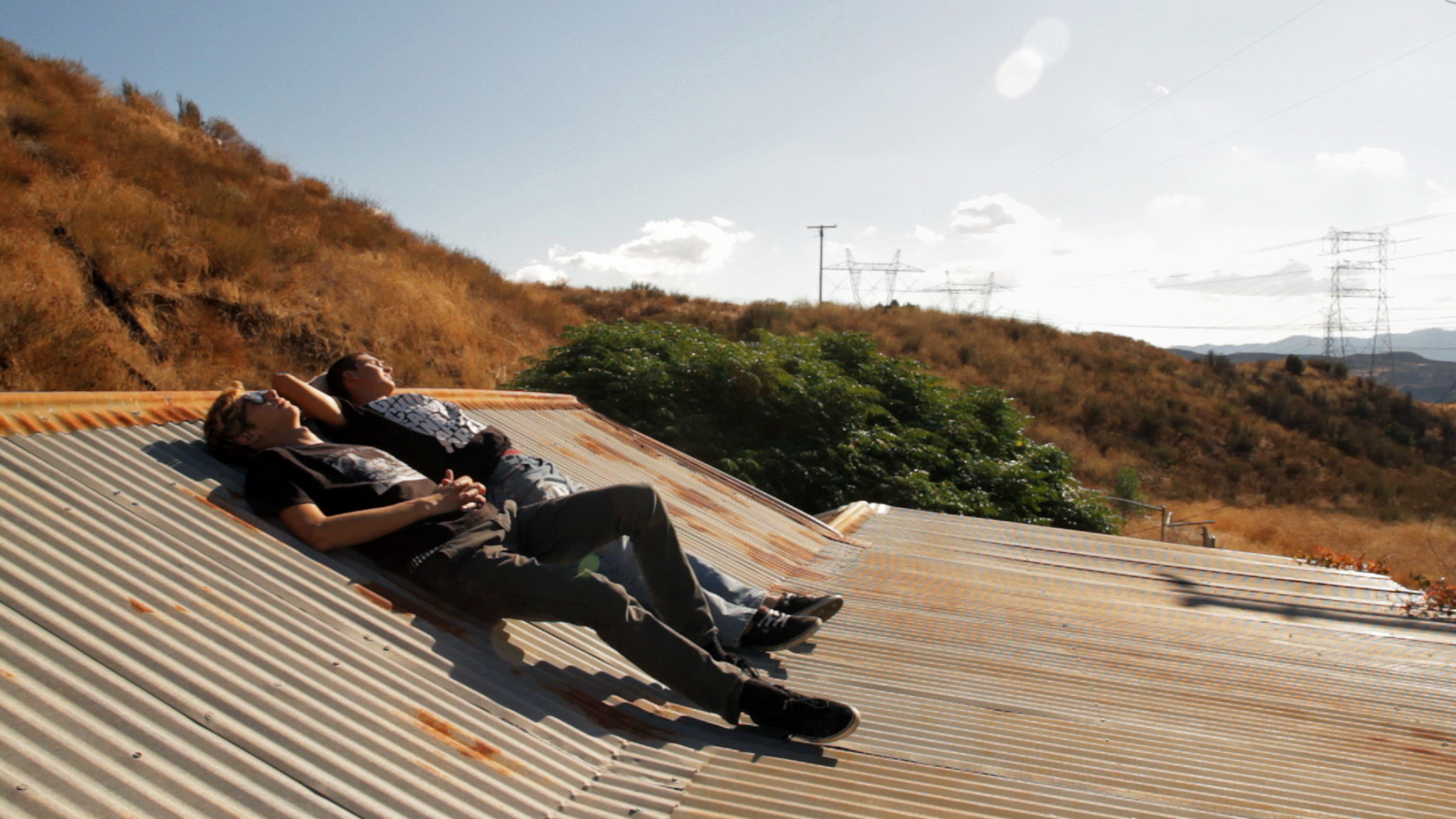Opening the digipak for Oscilloscope’s sister set of Jason Tippet and Elizabeth Mims’s Only the Young and Bill Ross IV and Turner Ross’s Tchoupitoulas reveals a striking pair of images. On the left, the three Zanders brothers from Tchoupitoulas are framed on the rocky shore near the Mississippi river, looking out at the body of water that physically prevents them from returning home after missing the last ferry. On the right are two of the three subjects in Only the Young, Garrison Saenz and Kevin Conway, relaxing on a rusty roof, framed by the desolate bushy plains surrounding them.
These images bring to mind an element explored by both films: the power of physical space on a young person’s cognitive development. Coincidentally, both Tippet and the Ross brothers were influenced to make their films based on their own adolescent experiences. The Ross brothers wanted to return to the New Orleans they’d discovered as children. Tippet, once a skateboarder like Saenz and Conway, found his subjects at a skating park in Santa Clarita, California, blocks away from his own childhood home.
In Only The Young, social institutions are strikingly absent in the portrayal of the lives of the three subjects (Saenz, Conway, and Saenz’s on-and-off-again girlfriend Skye Elmore). Tippet and Mims focus instead on the physical spaces the kids have claimed as their own: wide open skating parks; the half pipes, shot cartoonishly large, that Saenz and Conway attempt to master on their boards; abandoned, decaying houses and golf courses; streets teeming with car traffic, but devoid of pedestrians; and poster-adorned bedrooms. The three teens are devoutly Christian, though the film treats their self-proclaimed love for Jesus with neutral respect; rarely does the film show the presence of church community outside of a religious project called Ignition Skate Ministry that the two boys help out with. Their parents are largely absent, not only in the narrative, but in the kids’ own lives. What the film is left with is the frequently hilarious antics and conversations among the three teens, who have nothing better to do than hang out, granting the filmmakers and the viewers the privilege of their excellent company.
The tumbleweed-rolling emptiness in Santa Clarita couldn’t be more different than the frenetic energy of New Orleans, where the Ross brothers spent seven months shooting before stumbling upon the three Zanders boys, on their way to the magical city for their first trip. The Ross brothers frame their narrative through these kids’ virginal eyes seeing the city for the first time.Tchoupitoulas is largely successful in painting the manic bacchanalia of Mardi Gras, but the city competes with William Zanders for most vibrant, loudmouthed character. Frequently picked on by his two older brothers, Bryan and Kentrell, William is the most innocent and fearless, talking to strangers, peering into store windows with careless abandon, matching the melody of street buskers while humming and playing an invisible recorder. His young tenaciousness renders him incapable of sensing the possible dangers of the street; he bravely leads his brothers into a ghost ship and walks around like it’s no big thing. Despite being the youngest, William is the only one who really ingratiates himself into the communal space of the crowd-packed streets and in his own way, comes to own it.
IMAGE / SOUND:
Despite its beautiful packaging, this Oscilloscope Laboratories dual set was released on DVD only, a real shame in the case of Only The Young, with its bright, lucid cinematography. The 5.1 surround track is mostly acceptable on both films, and sufficiently fine-tuned to capture the crackling noises of skateboard wheels on concrete, and in the case of Tchoupitoulas, the Zanders brothers’ incessant arguing among the music-drenched soundscapes of New Orleans’s streets.
EXTRAS:
This set contains some undeniable gems for extras. The Only The Young disc contains several features that offer fascinating contextualization, both for Jason Tippet and Elizabeth Mims’s first debut feature (in the way of audio commentary and outtakes) and their own filmmaking development (with the inclusion of their first short, Thompson, which could be described as Only the Young-lite). The outtakes reel is particularly appropriate because so many of the film’s scenes feel off the cuff and earnest; the reel makes it obvious that any footage of these garrulous teens is compulsively watchable.
The Tchoupitoulas disc only has one extra outside of the theatrical trailer, a feisty, mesmerizing making-of documentary called Behind the Scenes with the Ross Brothers. This 15-minute short is a delirious mash of voiceover snippets from a radio interview, scenes of the filmmakers carousing while singing “Pure Imagination” from Willy Wonka & the Chocolate Factory, old radio ads about New Orleans, and footage of Mardi Gras. Included as a footnote, this cinematic jazz ditty is in many ways, more indicative of the Ross brothers’ talent than Tchoupitoulas itself.
OVERALL:
It makes perfect sense for Oscilloscope to release Only The Young and Tchoupitoulas together. Both beautifully portray youthful exuberance in American landscapes that are changing as quickly as the films’ adolescent subjects.

